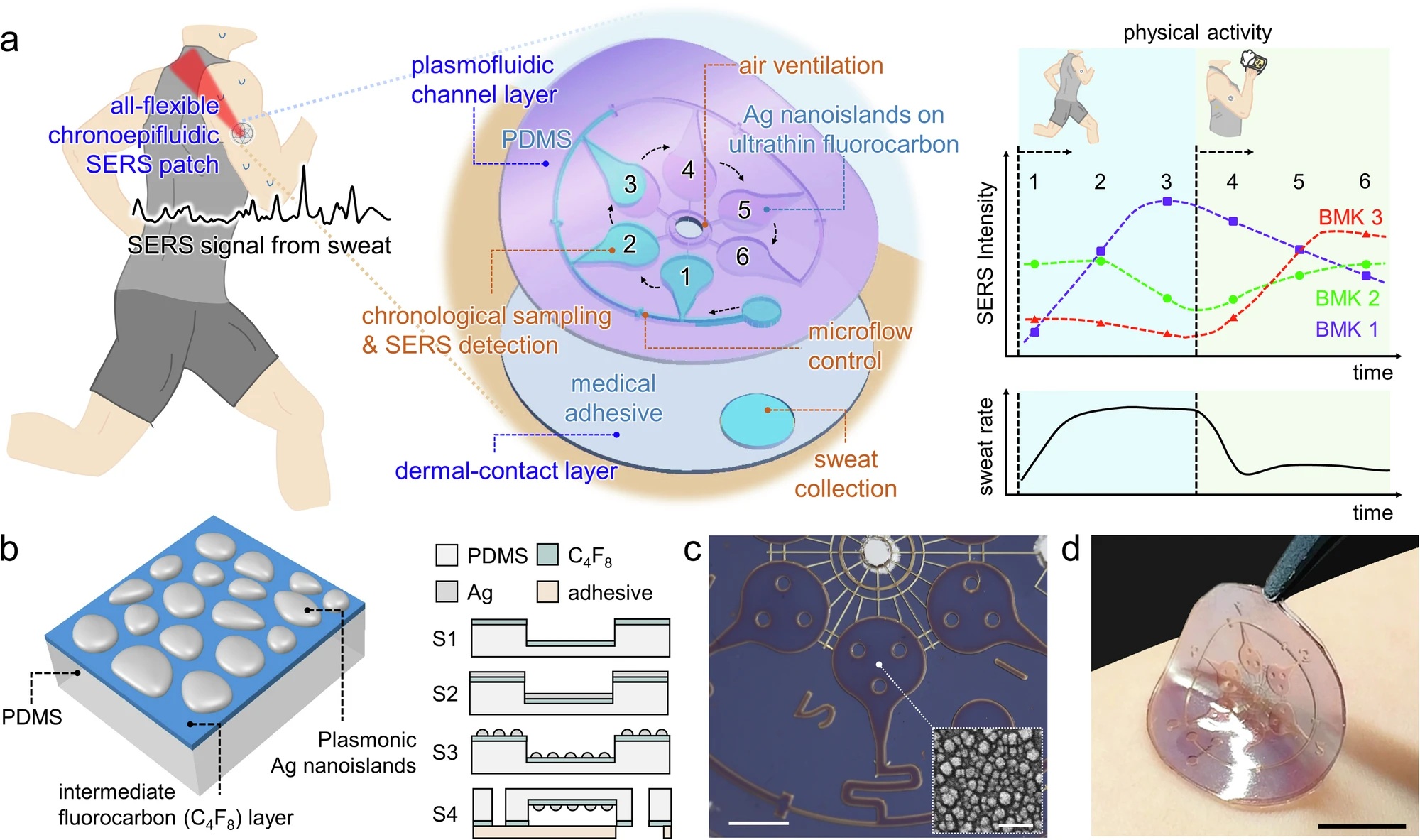
19 Sep Microfluidic Nanoplasmonic Patch for Metabolite Profiling in Sweat
Tracking how our bodies respond to food, exercise, and stress requires tools that can capture rapid metabolic changes as they occur. Traditional blood or urine sampling provides only snapshots, missing the continuous fluctuations that shape individual health. Sweat is an attractive alternative because it is abundant, non-invasive, and rich in metabolites, but existing sensors often rely on recognition molecules that limit coverage and flexibility. In this study, researchers developed a microfluidic platform employing an all-flexible chronoepifluidic surface-enhanced Raman spectroscopy (CEP-SERS) patch designed for label-free profiling of metabolites directly from sweat. The microfluidic patch integrates plasmonic nanostructures with microfluidic channels that collect sweat sequentially over time, enabling a chronological map of metabolic changes. By eliminating the need for labeling molecules or enzymes, it provides unbiased and multiplexed detection of sweat chemistry.
“The wearable patch adheres conformally to skin, collects sequential sweat samples, and supports label-free and multiplexed SERS detection of assorted metabolites. Machine learning-assisted quantification of lactate, uric acid, and tyrosine yields robust metabolic profiles in distinct physical activity states. This wearable optofluidic platform refines molecular sweat sensing and expands the potential for individualized phenotyping in proactive and data-driven healthcare. ”
The microfluidic device is built from a layered structure: a flexible plasmonic substrate made of silver nanoislands on fluorocarbon-coated PDMS, and a microfluidic chip as a sampler equipped with capillary bursting valves to divide sweat into separate time-stamped chambers. This ensures stable, sequential collection during activity. Machine learning models were trained on Raman spectra to accurately quantify metabolites such as lactate, uric acid, and tyrosine across physiologically relevant ranges. The patch was tested in human participants under fasting and after a purine-rich diet, while exercising. The results captured real-time increases in uric acid and tyrosine following diet, and tracked lactate fluctuations tied to exercise intensity.

“a Schematic illustration of an all-flexible chronoepifluidic SERS patch (CEP-SERS patch) comprising plasmofluidic channel layer (PCL) and dermal-contact layer (DCL). PCL includes an all-flexible plasmonic SERS substrate and a chronoepifluidic sweat sampler. The flexible SERS substrate features plasmonic nanoislands on ultrathin fluorocarbon-coated PDMS membrane using low-temperature solid-state dewetting of thin silver film. The sweat sampler sequentially collects the sweat via the microfluidic channel with capillary bursting valves, which spatially separates the sweat over time. DCL interconnects the PCL on the skin for stable sweat collection, which contains medical adhesive with a sweat collection port. The CEP-SERS patch provides conformal contact on human skin and label-free sweat profiling of diverse metabolites from sequentially sampled sweat. b Schematic illustration of micro and nanofabrication for the CEP-SERS patch. The device fabrication includes fluorocarbon coating (S1), thermal evaporation of Ag (S2), low-temperature solid-state dewetting (S3), and microfluidic encapsulation (S4). The ultrathin fluorocarbon film effectively dewets the thin metal film on the sweat sampler, resulting in plasmonic structures with strong electromagnetic hotspots, which facilitate highly sensitive SERS analysis. Optical images of (c) the PCL (Scale bar: 1 mm) with an inset SEM image of Ag nanoislands (Scale bar: 100 nm) and (d) the CEP-SERS patch on the skin (Scale bar: 10 mm).” Reproduced from Jeon, J., Lee, S., Chae, S. et al. All-flexible chronoepifluidic nanoplasmonic patch for label-free metabolite profiling in sweat. Nat Commun 16, 8017 (2025). under Attribution 4.0 International License.
The findings highlight how microfluidic nanoplasmonic platforms can move sweat analysis beyond static snapshots to real-time metabolic profiling. By combining sequential sampling, robust plasmonic sensing, and AI-based quantification, this flexible patch opens opportunities for personalized phenotyping in proactive healthcare. It demonstrates a pathway toward wearable systems capable of tracking biochemical responses to daily life, diet, and exercise, without needles or invasive procedures.
Figures are reproduced from Jeon, J., Lee, S., Chae, S. et al. All-flexible chronoepifluidic nanoplasmonic patch for label-free metabolite profiling in sweat. Nat Commun 16, 8017 (2025). https://doi.org/10.1038/s41467-025-63510-2 under Creative Commons Attribution 4.0 International License.
Read the original article: All-flexible chronoepifluidic nanoplasmonic patch for label-free metabolite profiling in sweat
For more insights into the world of microfluidics and its burgeoning applications in biomedical research, stay tuned to our blog and explore the limitless possibilities that this technology unfolds. If you need high quality microfluidics chip for your experiments, do not hesitate to contact us.


